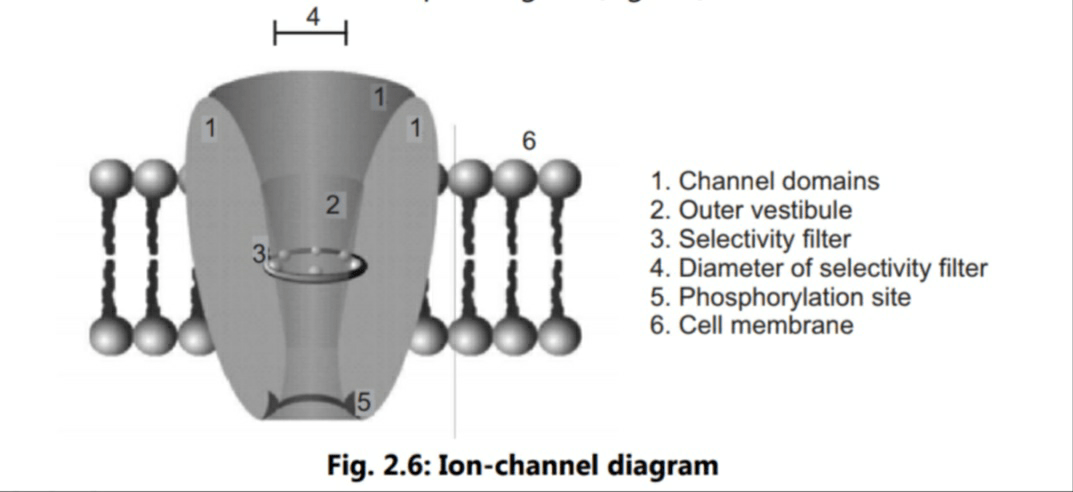Ion-channel Receptors
Ion channels are pore-forming membrane proteins which allow ions to pass through the channel pore. Their functions include establishing a resting membrane potential, shaping action potentials and other electrical signals by getting the flow of ions across the cell membrane, controlling the flow of ions across secretory and epithelial cells, and regulating cell volume. Ion channels are present in the membranes of all excitable cells. Ion channels are one of the two classes of ionophoric proteins, along with ion transporters including the sodium-potassium pump, sodium-calcium exchanger, and sodium-glucose transport proteins.
There are two distinctive features of ion channels which differentiate them from other types of transporter proteins:
• The rate of ion transported through the channel is very high; often 106 ions per second or higher.
• Ions pass through the channel down their electrochemical gradient, which is a function of ion concentration and membrane potential without the input of metabolic energy.
Ion channels are located within the membrane of all excitable cells and of many intracellular organelles. They are narrow, water-filled tunnels that only allow certain size and/or charge to pass through. Thus, they allow selective permeability. Some channels may be permeable to the passage of more than one type of ion, typically sharing a common charge: positive or negative. In many ion channels, passage through the pore is governed by a gate, which may be opened or closed in response to chemical or electrical signals, temperature, or mechanical force. Ion channels are integral membrane proteins, typically formed as assemblies of several individual proteins.
Biological Role
They are the important components of nervous system. Many toxins related to nervous system like venoms of spiders, scorpions, snakes, fish, bees, sea snails and others work by
modulating ion channel conductance and/or kinetics. In addition, they are key components involving rapid changes in cells like cardiac, skeletal, smooth muscle contraction, epithelial transport of nutrients and ions, T-cell activation and pancreatic β-cell insulin release. Ion channels are also targets for new drugs.
Classification
Ion channels are classified on following parameters:
1. Gating
The classification based on what opens and closes the channels. There are three subtypes in this category:
(i) Voltage-gated: Voltage-gated ion channels open and close in response to membrane potential. Some of the examples are as follows:
o Voltage-gated sodium channels
o Voltage-gated calcium channels
o Voltage-gated potassium channels
o Transient receptor potential channels
o Hyperpolarisation- activated cyclic nucleotide-gated channels
o Voltage-gated proton channels
(ii) Ligand gated: They are also known as ionotropic receptors. Some of the examples are as follows:
o Cation-permeable nicotinic Acetyl choline receptor
o Glutamate-gated receptors
o Acid-sensing ion channels (ASICs)
o ATP-gated P2X receptors
o Anion-permeable GABA-gated GABAA receptor
(iii) Other gating: In this case, gating includes activation and inactivation by second messengers from inside of the cell membrane rather than outside the cell, as in the case of ligands. Some of the examples are as follows:
o Some potassium channels like inward-rectifier, calcium activated, two-pore-domain
o Channelrhodopsin opened by photons
o Mechanosensitive ion channels opened by stretch/pressure/shear/displacement
o Cyclic nucleotide-gated channels, activated by cAMP/cGMP
o Temperature related channels, opened by hot or cold temperature
• Type of ions:
These channels are opened by specific ions as indicated below:
o Potassium channels
o Sodium channels
o Calcium channels
o Proton channels
o Non-selective cation channels for sodium/potassium/calcium
• Cellular organisation
Ion channels are classified based on their sub-cellular localisation. The plasma membrane accounts for about 2% of the total membrane of the cell, while intracellular organelles contain 98% of cell’s membrane. The major intracellular compartments are endoplasmic reticulum, Golgi apparatus and mitochondria. On the basis of localisation, ion channels are classified as follows:
o Plasma membrane channels
o Intracellular channels: They are further sub-classified as endoplasmic reticulum channels and mitochondrial channels
• Other: The classification is based on number of pores and transient potentials. Most of the ion channels are single pore; however there are few two-pore channels. Transient receptor potential channels are also termed as TRP channels.
2. Structure
Channels differ with respect to the ion they let pass (sodium/potassium/chloride), the ways in which they may be regulated, the number of sub-units they are composed of and other aspects of the structure. An example of voltage-gated channels which underlie nerve impulse can be cited here. It consists of four sub-units with six transmembrane helices each. On activation, these helices move about and open the pore. Two of these six helices are separated by a loop that lines the pore and is the primary determinant of ion selectivity and conductance in this channel class. Pore can determine the selectivity of the channel. Gate can be formed either inside or outside the pore region. (Fig. 2.6).
Ion Channel Blockers
A variety of inorganic and organic molecules can modulate ion channel activity and conductance. Some examples are as follows:
o Tetrodotoxin (TTX): It blocks sodium channels
o Saxitoxin: It blocks voltage-dependent sodium channels
o Lidocaine and Novocaine block sodium ion channels
o Dendrotoxin blocks potassium channels
o Iberiotoxin blocks potassium channels
o Heteropodatoxin blocks potassium channels
3. Diseases
Various disorders which disrupt normal functioning of ion channels have disastrous consequences for the organism. Genetic and autoimmune disorders are known as channelopathies. Some of the examples are as follows:
o Shaker gene mutations cause defect in voltage-gated ion channels, slowing down repolarisation of the cell.
o Equine hyperkinetic periodic paralysis, human hyperkalaemic periodic paralysis (Hyper PP) are caused by a defect in voltage-dependent sodium channels.
o Generalised epilepsy with febrile seizures plus (GEFS +).
o Episodic ataxia (EA), provoked by stress, startle, or heavy exertion by exercise.
o Familial hemiplegic migraine (FHM).
o Long QT syndrome, due to defect in potassium channels.
o Brugada syndrome, a ventricular arrhythmia caused by defect in voltage-gated sodium channel.
o Cystic fibrosis, caused by defect in chloride channels.
o Some types of cancers like glioblastoma multiforme, caused by defect in potassium/chloride channels.

